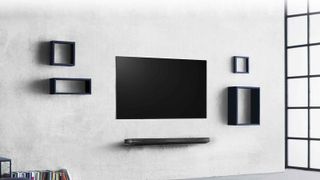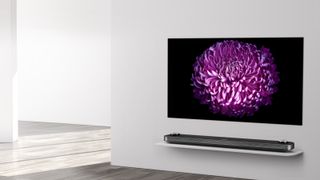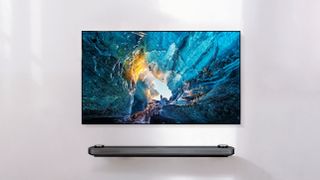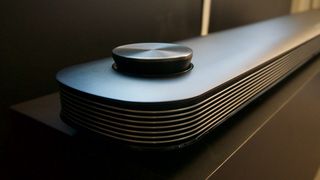LG Signature OLED W7 (OLED65W7) review
Thinner than we even thought possible
OUR VERDICT
There’s a lot to like about LG’s new OLED. A super-slim design alone wouldn’t have been enough to warrant the extra cost to upgrade to LG’s latest panel. But the thin frame on top of a Dolby Atmos soundbar on top of four types of HDR support on top of the magnetic mounting system on top of the new webOS 3.5 operating system surely did the trick.
FOR
- Insanely slim design
- Color, clarity and contrast
- Future-proof HDR
- Magnetic strip mounts
AGAINST
- Flat TV cable mars appearance
- Motion issues with TruMotion
- Soundbar isn’t true Atmos
The LG W7 OLED is truly something special. Not only is it one of the thinnest TVs to ever grace our vision (it’s 2.75mm thin), but it’s also one of the most gorgeous. When fed the right kind of content – in this case, 4K HDR10 or Dolby Vision video – it truly shines.
[Update: The LG W7 is every bit as impressive at the end of 2017 as it was when it was first released. It might feature the same picture quality as the cheaper TVs in its range, but its unique form-factor makes it a stunning TV to look at. It's pricey, so make sure you keep an eye out for deals if you want to pick it up, and as always check out our guide to the best 4K TVs if you want to see what your other options are.]
But, before we expound upon how excellent this TV truly is we feel we should warn you: this level of performance is costly. The 65-inch version of the TV – the OLED65W7 – is $7,999 (around £6,500, AU$10,500). Before you write this off as an unobtainable piece of tech you might never have in your home, though, that’s exactly how much the G6 OLED cost last year – which means you might be able to afford this down the line after some price drops.
That said, if you decide to buy the screen right now, your money stretches a bit farther this year. Not only are you getting a slimmer all-around TV, but you’re getting a better soundbar and a moderate improvement in terms of brightness and contrast over the 2016 model.
There are still some key negatives that hold the W7 back from reaching audiovisual nirvana (see: sub-par Dolby Atmos performance and some issues with motion), but LG’s 2017 flagship TV gets within inches of becoming one of the best screens of all-time.

Design
While the W7 excels in nearly every aspect of its design, the highlight here is its slimness. When wall-mounted – and yes, it has to be wall-mounted – it blends into its surroundings. LG calls the W7’s design ‘picture-on-wall’ and it’s not hard to figure out why.
But this level of slimness needs some quantifying: It’s thicker than a sheet of paper (we’re not quite there yet) but it’s slimmer than your cell phone. The closest example we can come up with is a magazine – though admittedly that depends on which magazines you subscribe to, if any. The best descriptor is, perhaps, the actual measurement: 2.75mm. Yep, 2.75mm.
Now, of course, that’s just the slimness of the panel itself. When wall-mounted the overall number is slightly higher (somewhere around 3.85mm). It’s not a stretch to call this one of the slimmest TVs on the market, and definitely one of the sleekest, too.
On the weight side of the equation, the 65-inch version of the screen only weighs about 17 pounds (8Kg), which means you should have no problem wall mounting it. We didn’t get an exact number for the 77-inch version of the screen, but from the sounds of it, the additional 12 inches would only add an extra pound or two.

Some people we’ve spoken to about the television since its debut at CES 2017 remarked that they’d be scared to hold the W7 for fear that it’d break. But while the screen is incredibly slim, it has a fair bit of flex to it – so much so that you shouldn’t worry too much about your investment’s long-term health.
One of the ways LG saves space on the W7 itself is by not including any internal speakers – the only way to get volume out of the TV itself is through the included soundbar. The soundbar is probably the most important feature about the TV seeing as it helps the W7 from the competition, but also because it contains all the connections for the screen.
While the soundbar is quite nice – boasting an out-of-the-box Dolby Atmos configuration – the inability to better direct audio flow might irk some AV enthusiasts looking for complete control over their home entertainment setup. Speaking of connections, the W7 supports four HDMI inputs, three USB, one RF In (Antenna/Cable), one Composite In, one Component In, one Ethernet, one Optical and one mini jack port.
The other problem, of course, is that the TV still needs to connect to the soundbar somehow and the solution LG’s gone for is a flat, white cable that – while not ugly in its own right – mars the illusion that the TV is part of the wall.
Screen sizes available: 65-inch, 77-inch | 4K: Yes | HDR: Yes (HDR10, HLG, Dolby Vision, YouTube VP9) | Panel technology: OLED | Smart TV: Yes, webOS 3.5 | Curved: No | Dimensions: 57.1 x 32.5 x 0.15 inches (W x H x D) | 3D: No | Inputs: four HDMI, three USB, one RF In (Antenna/Cable), one Composite In, one Component In, one Ethernet, one Optical and one mini jack port
Design TL;DR: Beautiful slim design that makes one or two compromises along the way.

Smart TV: webOS 3.5
While other manufacturers have made the switch away from proprietary operating systems and latched onto third-party sources like Android TV, LG has stayed strong with webOS. But that’s an easy decision to justify – webOS 3.5 is a supremely versatile, easy-to-operate OS that should help you find content quickly thanks to a robust universal search function.
As far as content selection is concerned, there are plenty of options here: Netflix, Amazon, YouTube, Vudu, Hulu and Google Play Movies and TV come preinstalled with the TV, while lesser-known apps like UltraFlix, Crackle and FandangoNow can be found in the store.
If you can’t find what you’re looking for (cough, HBO, STARZ, Showtime, CBS All-Access, Sling TV, etc...) you can always select the screen cast function to mirror your mobile device – the only downside being that LG’s OLED TVs only support Android and Windows devices.
If you’re really struggling and want to watch something specific, however, you can always provide your own content with a USB stick.
If you’re coming from a previous webOS TV, you’ll feel right at home here. The only major difference between webOS 3.5 and the deprecated 3.0 version is that this year’s update to LG’s Smart TV platform includes Magic Link, a content recommendation service powered by LG, and Channel Plus, an aggregate of 70-plus free streaming digital channels including sports and news from national broadcast networks such as Fox Sports, Newsy, Sports Illustrated, TIME, Bloomberg, People, Funny or Die, Fail Army and more into your existing over-the-air TV channel options.
If you’re coming from another platform with a few more options – like Roku or Android TV – you might be slightly disappointed in the slightly more limited selection of apps here.
Smart TV TL;DR: webOS might not have the robustness of Roku but it’s still one of the best operating systems in existence.
HD/SDR performance
We have to admit, HD/SDR performance isn’t our favorite part of the W7 OLED – or any OLED for that matter. That’s not to say that the W7 does a poor job making your old 1080p video shimmer, but it’s that the results can be inconsistent.
While most content looks great 90% of the time, there are some noticeable issues here. The first is something that we spotted last year in our OLED E6 review: flesh tones have a strange hue when displayed in HD/SDR. Not only are they more red than they should be, but they have a fair bit of graininess to them that you wouldn’t normally find on a standard LED-LCD screen.
Now, admittedly, that’s a fairly specific complaint. But it’s with that level of depth you have to look find something wrong with OLED’s picture performance.
By and large, pictures look amazing. Not only do the rich, inky blacks look just as good as they did on last year’s panels, but this year’s crop of OLEDs have a 25% increase in brightness, meaning that even regular SDR content can be bright without losing details in the image – also known as blow-out or cropping.

Realizing this potential, LG has added a new feature to this line-up in the form of HDR Effect, a picture mode that boosts contrast for HD/SDR content. In practice there’s a noticeable difference between HD/SDR content watched in cinema mode (what LG considers its most versatile mode) and anything watched in HDR Effect. It’s not massive, and certainly not as robust or as vibrant as content watched in native HDR, but it’s a fairly decent stopgap.
Of course, the biggest issue that LG’s panels face (and have faced for as long as we can remember) is how the set goes about handling motion.
Straight out of the box, the W7 OLED comes with a feature called TruMotion turned on. The main purpose of this feature is to build additional frames to help smooth out high-motion scenes that you’d find in sports or action films. In practice, it gives most content a soap opera effect and an unnatural judder. Long story short, it should be turned off immediately.
One other small snafu you might find here is that the OLED W7 doesn’t support 3D. In fact, no OLED TV that LG makes this year will support 3D. While that might disappoint anyone who has bought every 3D film to date, this decision probably won’t affect many of you.
HD/SDR performance TL;DR: Up-conversion and motion handling still aren’t LG OLED’s strong suits, but otherwise performance is near flawless.
4K/HDR performance
Here’s where we’d usually give the long spiel about how OLED offers infinite contrast, the best black levels, individually lit pixels, so on and so forth...
But you’ve heard that all before. By now you know exactly what OLED offers – simply gorgeous color and contrast ratios that no LED screen can match, no matter how many Quantum Dots you throw at it.
But you’ve heard that all before. By now you know exactly what OLED offers – simply gorgeous color and contrast ratios that no LED screen can match, no matter how many Quantum Dots you throw at it.
This year you can expect both HDR10 and Dolby Vision support, which we saw on last year’s models, as well as Hybrid Log Gamma which is used to transmit HDR signal through your cable provider.
We spent a fair bit of time with the two main types of HDR – Dolby Vision and HDR10 – and walked away feeling impressed by both. Dolby Vision content looked a hair sharper than its static metadata counterpart, HDR10, but both types of content played excellent on the OLED W7. (Want even more details about the differences between the two? Read this: HDR10 vs Dolby Vision)
That being said, one new feature LG has included this year is the ability for the TV to recognize which kind of content is being displayed and giving you a heads up. If you’re watching Dolby Vision content, for example, the screen will have a bubble that flashes in the top right corner that affirms your suspicions. The same will happen for Dolby Atmos content, meaning you’ll never guess if you’re hearing the full surround sound experience and is a big help when troubleshooting.
Simply said, all this new technology makes the screen look amazing.
Some of that outstanding performance is due to the 25% in brightness over last year’s sets (OLED can’t get as bright as most UHD Alliance-certified LED-LCD screens, but can go much, much darker), but a lot of it is coming from the processor. Improvements in this area consist of a huge cut to input delay – a problem most gamers had on last year’s sets – and the ability of the panel to display even darker content without losing fidelity.
4K/HDR performance TL;DR: Performance here is immaculate, both for 4K HDR10 content as well as anything in Dolby Vision.

Sound
For the most part, TVs generally don’t sound great on their own. They usually ship with 5-watt speakers that can’t quite cut it, either for cinephiles or audiophiles looking for an audio experience on par with what they’re seeing on the screen.
Of course, that being said, nothing could be farther from the case here. The W7’s Dolby Atmos soundbar has truly stunning performance. Detail is maintained even at the highest levels, but it’s also supremely well-balanced – mids, highs and lows all play nicely here.
The experience you’ll find here is one of the best in-the-box solutions to be sold, and LG certainly should be commended for taking the time to create such an excellent all-around package.
But (and there’s always a ‘but’) while the soundbar blows any traditional TV speakers out of the water, it’s not quite a true Dolby Atmos soundbar.
This deserves some explanation. So first thing’s first: LG calls it a 4.2 speaker – implying that it has four front-firing drivers and two top-firing drivers. It doesn’t.
Instead it’s a two-channel soundbar with two additional speakers on top that actually don’t upfire at all. Instead there’s software inside the TV itself that virtualize Dolby Atmos and attempt to recreate the effect without bouncing sound off of the ceiling.
Instead it’s a two-channel soundbar with two additional speakers on top that actually don’t upfire at all. Instead there’s software inside the TV itself that virtualize Dolby Atmos and attempt to recreate the effect without bouncing sound off of the ceiling.
For folks who have a vaulted ceiling or non-reflective surfaces, LG’s solution might sound a bit better than traditional Atmos soundbars. For everyone else, however, it won’t.
Sound TL;DR: One of the best out-of-the-box audio performances of any TV. That said, other Atmos soundbars do a better job.
Other panels to ponder
Let’s be honest, there’s not really a TV set that compares with the W7 at this point. With some of the best color, clarity and contrast in any screen available, the W7 might hold the title of the best TV on the market, bar none.
But, unlike past years, LG isn’t the only one with OLED screens – both Philips and Sony have new series of OLED screens for 2017 and they look incredible, too. The models you want to keep your eye on are the Sony Bravia A1E OLEDand Philips 901F OLED, both of which promise to rival the W7 in terms of performance. We’ll be excited to see how all three stack up.
If you’re looking to save some money and want to stick to an LG OLED, your best option might be LG’s C7 – the new entry-level OLED screen that uses the same panel as the W7, but trades the Atmos soundbar for a set of built-in speakers. The 65-inch C7 will go for $4,999 when it launches later this year, which means you’ll save about $3,000 by cutting out the soundbar and sacrificing the picture-on-wall design for something a little less sleek – not terrible trade-offs for this level of performance in our opinion.
Verdict
There’s a lot to like about LG’s new OLED. A super-slim design alone wouldn’t have been enough to warrant the extra cost to upgrade to LG’s latest panel. But the thin frame on top of a Dolby Atmos soundbar on top of four types of HDR support on top of the magnetic mounting system on top of the new webOS 3.5 operating system surely did the trick. This incredibly gorgeous TV isn’t without its faults (see: motion handling, its sticker price and soundbar issues), but in terms of sheer picture performance there’s nothing else like it right now.








0 comments: